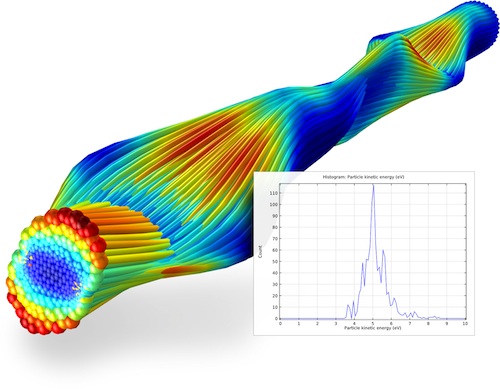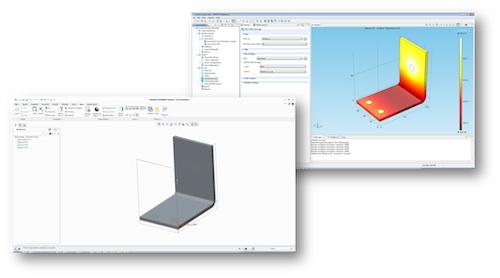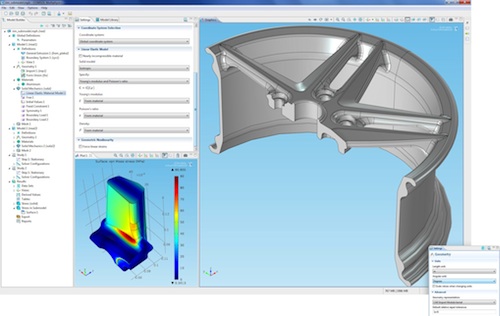COMSOL Version 4.2a Unveiled at the COMSOL Conference in Boston
New version expanded with particle tracing, image-to-material conversion and Digital Elevation Map import.
October 19, 2011
By DE Editors
COMSOL Inc. has unveiled COMSOL Multiphysics version 4.2a. With the introduction of version 4.2a COMSOL says it has created an integrated analysis platform. Version 4.2a sees the debut of two new products, Particle Tracing Module and LiveLink for Creo Parametric, as well as new modeling features for the users of COMSOL Multiphysics and its application specific add-on modules.
Image-to-Material Conversions
One of the features of 4.2a is image-to-material conversion. This process can shorten time to solution for image-based simulation. With this new capability engineers and scientists in industries such as life science and semiconductors can now bypass both geometry creation and computational-demanding meshing of microscopic details. They can use image data to represent 2D material distributions or to identify regions with different materials by their color or gray scale. Images used in this way can have many origins such as scanning electron microscope (SEM), computed tomography (CT), or magnetic resonance imaging (MRI).

A particle tracing simulation with trajectories of argon ions in a quadrupole mass
spectrometer (left). The electric fields that exert forces on the ions have both
AC and DC components and the combination of the two is essential for the
function of the spectrometer. The figure on the right shows the ion energy
distribution function at the spectrometers collector.
Digital Elevation Map Import
Version 4.2a also comes with a new Digital Elevation Map interpolation feature that directly supports the importation of topographical surface data formatted in the U.S. Geological Survey’s (USGS) Digital Elevation Map (DEM) file format. Users can freely combine DEM surfaces with other surfaces and solids to form a volumetric representation of both geometry and mesh. Geometric structures resulting from DEM import are generic in the COMSOL environment and handled in the same way as are mechanical CAD structures.
CAD Modeling and new LiveLink for Creo Parametric
With the new LiveLink for Creo Parametric, COMSOL Multiphysics integrates with the latest design software from PTC. By establishing an associative connection between the two applications any changes to a feature in the Creo Parametric CAD model automatically update the geometry in COMSOL Multiphysics while retaining physics settings. Additionally, all parameters specified in Creo Parametric can be interactively linked with your simulation geometry, which enables multiphysics simulations involving parametric sweeps and design optimization to sync up with the CAD program.

Simulation of a bus bar electric conductor using the LiveLink for Creo Parametric.
Geometric dimensions are synchronized in both software which allows for simulations
where the original dimensional parameters are retained throughout the simulation process.
The Parasolid geometry kernel from Siemens PLM Software is now the default geometry kernel for users of the CAD Import Module and the LiveLink products for CAD. COMSOL Multiphysics’ extensive Model Library is now accessible from within the One Window Interface that is included with the LiveLink for SolidWorks. Animations and images can now be created from the One Window Interface.

The CAD Import Module and the CAD LiveLink products enable import and
geometry repair of the original CAD model. By using any of these products,
the geometry representation now defaults to the Parasolid kernel from
Siemens PLM, which is also used when creating geometries from scratch.
Particle Tracing Module
The Particle Tracing Module is a new feature of the COMSOL Multiphysics environment, which allows for computing the trajectory of particles in a fluid or electromagnetic field, including particle-field interactions. Any COMSOL add-on module combines seamlessly with the Particle Tracing Module, giving users access to additional modeling tools and fields to drive the particle motion. Applications include flow visualization, mixing, spraying, particle separation, mass spectrometry, ion optics, beam physics, ion energy distribution functions, acoustic streaming, and ray tracing.
Results and Visualization
Version 4.2a’s new Join Data Set function compares solutions corresponding to different meshes, time steps, or parameter values. Users can form combinations of solutions using the operation’s difference, sum, product, quotient, and more general and explicit expressions. Any scalar quantity of interest can be visualized by slice plots or isosurface plots. A new addition to slice and isosurface plots is the slide controller for the location of the slices and surfaces within the plots.
Heat Transfer Module
External radiation sources can now be defined in the Heat Transfer Module as sources at infinity or as point sources at a finite distance. When defining a source at infinity, users input the power per unit area. Another new feature of the Heat Transfer Module is that users can define radiation on both sides of a boundary when surface-to-surface radiation is used, according to the company.
Electromechanics Multiphysics Interface
A new Electromechanics multiphysics interface combines solid mechanics and electrostatics with a moving mesh to model the deformation of electrostatically actuated structures. A suite of new electromechanical tutorials are available showing 2D and 3D models of a biased resonator for stationary analysis, the frequency response, the normal modes, the pull-in voltage, and the transient response.
For more information, visit COMSOL.
Sources: Press materials received from the company and additional information gleaned from the company’s website.
Subscribe to our FREE magazine, FREE email newsletters or both!
About the Author
DE’s editors contribute news and new product announcements to Digital Engineering.
Press releases may be sent to them via [email protected].






